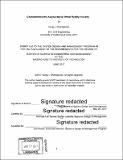Characterizing the augmented & virtual reality industry
Author(s)
Gharibjanian, Varag I
DownloadFull printable version (15.99Mb)
Alternative title
Characterizing the augmented & VR industry
Characterizing the ARNR industry
Characterizing the augmented and virtual reality industry
Other Contributors
System Design and Management Program.
Advisor
Michael A.M. Davies.
Terms of use
Metadata
Show full item recordAbstract
The information age has included several computing platforms and interfaces to enable humanity. Each computing platform has had its capabilities and limitations. From mainframe computers to personal computers, and now to smartphones, we have seen a revolution in computing that has had several advantages for society, in spaces from education to healthcare. However, these devices have their limitations and their innovation is becoming incremental. The growth of data and content, along with the insatiable demand to view and analyze it and content - calls for a new platform that can enable such experiences. There have been several candidates for such interfaces, but none of them have the promise of Augmented Reality (AR) or Virtual Reality (VR) today. These technology candidates, although in the spotlight now, have had several waves before, unfortunately with very limited success. This time, however, the outcome seems poised to be different. Smartphone technology, particularly displays, processors, and other microchips, along with wireless technology have increased capabilities and driven costs down dramatically, enabling some of the core components of Augmented and Virtual Reality (ARNR). Industry players, including venture capitalists, engineers, sales and marketing, consultants, and others have begun gathering data on this emerging industry. However, there has been little synthesis thus far, nor a comprehensive view that seeks to harmonize these data points to clearly describe the state of the industry as a whole and its likely future. Furthermore, little analysis has been done to analyze the industry with management related academic studies of the past. Using several different types of data, analysis, and projections, the paper shows that although Augmented Reality and Virtual Reality have begun to show genuine benefits over traditional computing platforms, the behavioral change required for its evolution in to a mainstream general purpose computing platform is still significant. This makes AR/VR great for enterprise use cases, such as construction, field work and training, but limited in day to day consumer computing. With this analysis we can also identify high and low value market segments and use cases within the industries, prognosticate the evolution of different platform architectures or types of AR/VR, and begin to outline the implications for various stakeholders within the industry, such as Venture Capitalists.
Description
Thesis: S.M. in Engineering and Management, Massachusetts Institute of Technology, System Design and Management Program, 2017. Cataloged from PDF version of thesis. Includes bibliographical references (pages 77-81).
Date issued
2017Department
Massachusetts Institute of Technology. Engineering and Management Program; System Design and Management Program.; Massachusetts Institute of Technology. Integrated Design and Management ProgramPublisher
Massachusetts Institute of Technology
Keywords
Engineering and Management Program., Integrated Design and Management Program., System Design and Management Program.